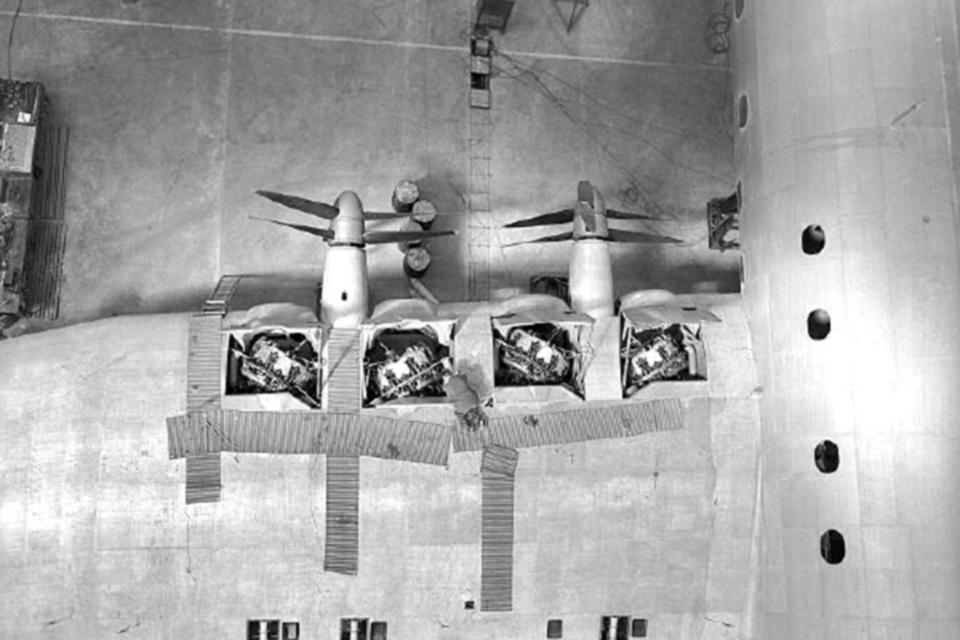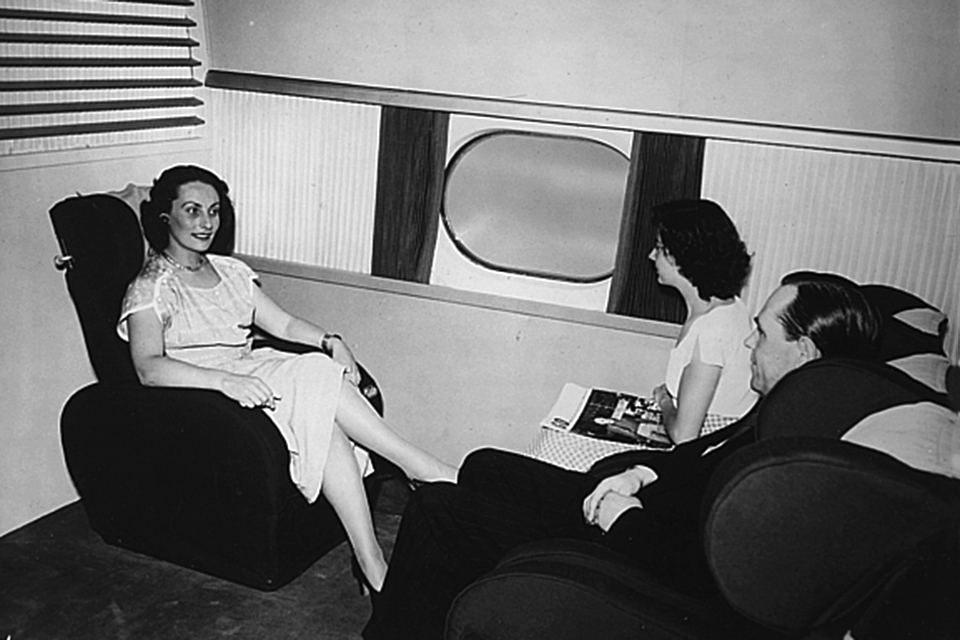The largest airplane ever built by Britain was also among the most controversial.
In December 1942, even as World War II was still raging, the British government felt sufficiently confident of victory to form a committee to determine what types of aircraft Britain’s airline industry would require after the conflict. Headed by Air Minister John T.C. Moore-Brabazon, 1st Baron Brabazon of Tara, the so-called Brabazon Committee came up with a series of recommendations for five different categories of airliners. By far the most ambitious was its “Type 1,” which specified a 100-ton, eight-engine, land-based airliner capable of carrying 100 passengers a distance of 5,500 miles at a cruising speed of 250 mph.
Eventually built and flown, and named after the chairman of the committee that conceived it, the Bristol Brabazon remains the largest airplane ever built in Britain. It also remains a subject of controversy. Some have described it as an engineering masterpiece and the precursor of the modern jumbo jet, but it’s also been dismissed as a useless and expensive white elephant that no body in the airline industry really wanted.
The Bristol Aeroplane Company was selected to develop the Type 1 airliner because it had already been working on a preliminary design study for a 100-ton, eight-engine strategic bomber. Bristol’s bomber design seemed a natural starting place from which to begin developing the airliner. Drawings of the proposed bomber indicate it would have looked a bit like the Convair B-36, with sharply swept wings that incorporated buried engines driving pusher propellers. Unlike the B-36, the Bristol bomber would have had eight engines, with pairs of power plants coupled together to drive contrarotating propellers. Although the engines’ direction was to be reversed to a tractor configuration on the airliner, the idea of using coupled engines to drive contrarotating props was retained.

Bristol was contracted to build two prototypes of what it called the Type 167, with an option for 10 production models. Led by Leslie G. Frise, the design team included some of Britain’s brightest and most innovative minds. They were able to begin actual construction in October 1945, shortly after V-J Day, which was just as well, because it was to take them nearly four years to complete the first prototype.
The Brabazon’s size was truly unprecedented. Fully loaded, it weighed 130 tons. The fuselage was 177 feet long, and its 230- foot wingspan was 35 feet longer than that of a Boeing 747. The engineering that went into the prototype was equally impressive. The cabin was fully pressurized and air-conditioned. All of the flight controls were hydraulically powered. To save as much weight as possible on the huge airliner, its airframe was covered with a stressed skin fabricated from light-alloy metal sheets of different, nonstandard gauges.
The most visually striking engineering feature was the power system. Eight 2,650- hp Bristol Centaurus air-cooled radial engines were embedded in the wings. Each coupled pair of engines drove contrarotating propellers mounted on the end of a slim nacelle containing only the propellers’ drive shafts. The propeller pitch could be reversed to aid in slowing the airplane down after landing. The arrangement gave the visual impression of an impossibly large aircraft powered by four impossibly small engines.
Even during the early stages of development the Bristol team recognized that the 21,200 hp provided by eight piston engines would be little more than adequate for an aircraft this size. The first prototype had to be built that way because the turboprop engines the designers really wanted were not yet available. The second prototype was to be fitted with eight newly developed Bristol Proteus turboprops, in coupled pairs similar to the first prototype’s arrangement. The Proteus would develop 4,400 hp—66 percent more than the Centaurus.
Simply getting the Brabazon built and off the ground entailed draconian measures. The gargantuan airliner would be assembled in a building covering eight acres. An entire village, which had survived the worst that Luftwaffe bombers could dish out in the war, was demolished and its inhabitants relocated to accommodate the 8,000-footlong runway the designers thought the Brabazon would require to take off.
Although it was completed in 1947, such was the Brabazon’s unprecedented nature that nearly two years of ground tests were deemed necessary before it was finally cleared to take wing. In the meantime, many skeptics insisted it was too big ever to get off the ground, while critics complained about the £12 million spent to build it.
The first flight finally occurred on September 4, 1949, witnessed by some 10,000 spectators, including more than 250 reporters, photographers, newsreel cameramen, radio commentators and even television broadcasters. As the giant rose into the air, using only a quarter of the distance of the enormous runway that had been built for it, test pilot Arthur J. “Bill” Pegg was heard to exclaim, “Good God, it works!”
The Brabazon had a top speed of 300 mph, but at its cruising speed of 250 mph it could fly 5,500 miles. Rate of climb was 750 feet per minute at a maximum takeoff weight of 290,000 pounds, and service ceiling was 25,000 feet. It could carry 100 passengers and a crew of at least six.
Despite the fact that the Brabazon had proven itself in the air, it failed to win favor with the airlines—even Britain’s national airline, BOAC. The problem wasn’t that it didn’t fly well, it was simply that the basic premise upon which the design had been based was outdated. The Brabazon’s design grew out of the prewar conception of air travel as a luxury reserved for the wealthy. Passenger accommodations within its fuselage were laid out on a scale far beyond even what we think of today as “first class.” Passengers were seated in private cabins that could be converted into sleeping berths. The plane boasted a bar, smoking lounge, dining area and even a 32-seat cinema. The Brabazon harked back to the days of air travel on Graf Zeppelin and the flying boats of Imperial Airways. Small wonder such a large airplane could accommodate only 100 passengers, and equally unsurprising that airlines of the late 1940s believed it would never be cost effective.

Air travel had changed since the 1930s. The airlines no longer saw their planes as flying ocean liners. The cost of air travel was falling, and airliners were being transformed into aerial buses. Simply being able to fly across the ocean was no longer sufficient; airliners now had to be able to accomplish that feat while carrying enough passengers to earn a profit. Although the Brabazon couldn’t do that, the Americans had developed several air liners that could, including the Douglas DC-6, Lockheed Constellation and Boeing Stratocruiser. Significantly, BOAC took delivery of its first Stratocruiser only a month after the Brabazon’s maiden flight.
The Brabazon performed many additional test and demonstration flights during the next 2½ years, but attracted no interest from the airlines. It was finally grounded in 1952 and eventually scrapped. The second prototype, fitted with the turboprop engines that were expected to boost its performance by 50 mph, was never completed.
While many in Britain considered the money spent on the Brabazon wasted, the effort Bristol expended on it was not. The facilities constructed at Filton were put to use in developing the Bristol Britannia, a successful airliner far better suited to the air transport conditions of the day. Powered by four of the Proteus turboprops developed for the Brabazon, the Britannia weighed almost 40 percent less than its enormous predecessor, yet could transport the same number of passengers across the Atlantic at a cruising speed more than 100 mph faster. Bristol delivered 85 Britannias, not counting another 72 built under license in Canada.
Although the most conspicuous aircraft derived from the Brabazon Committee had proved to be misconceived, not all its recommendations turned out badly. The committee’s work led to the development of several successful transports, including the de Havilland Dove, the Vickers Viscount and the first production jet airliner, the de Havilland Comet. As for the Brabazon itself, many historians still insist its main problem was not that it was a white elephant but that, as the predecessor of the modern jumbo jet, it was simply 20 years ahead of its time.
Originally published in the May 2014 issue of Aviation History. To subscribe, click here.





